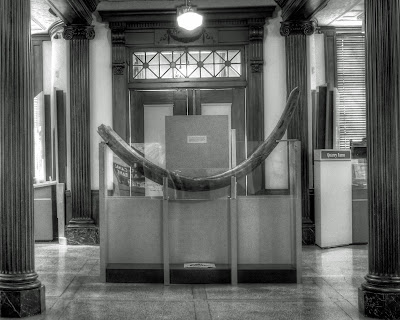By Rachel Dworkin, archivist
Over the years, I must have seen the logo of Ace Photo Studio on the back of a hundred photos in our collection, but I didn’t know much about the studio or George “Ace” Horsey, the man who owned it. Then two of his nieces came in looking to see what we had on their family. In the end, they wound up educating me! They kindly shared their family’s story with me so I, in turn, could share it with you.
George “Ace” Horsey Jr. (1926-1990) was born in Salisbury, Maryland one of the seven children of Danie and George Horsey Sr. He was always interested in photography. While serving in the United States Army Air Corps in World War II, he got an opportunity to take a training course on the subject. In 1950, Horsey, his wife Mary, and their young family moved to Elmira so he could take a job at the General Electric (G.E.) Foundry as the plant photographer. He took pictures for advertising purposes and the G.E. News, the company newspaper. In 1956, he was elected sergeant-at-arms in the plant’s Electrical Workers Union and served on the labor contract negotiation team at one point.
 |
| From G.E. News, January 15, 1954 |
Outside of work, Horsey was a member of the Douglas A.M.E. Zion Church where he frequently took pictures of members and events. Quite a number of his photographs ended up in the local newspaper throughout the 1950s. In 1956, he began volunteering at the Neighborhood House where he served as the instructor for the Camera Club. He took kids on photo shoots to area parks, taught them how to develop film, and served as judge during their annual photography show. He eventually became involved on the Neighborhood House board of trustees, serving as treasurer for a time.
 |
| Douglas A.M.E. Zion Church choir, ca. 1960s |
Horsey and his family prospered in Elmira. He and Mary had four children: Mary, Barbara, Vanessa, and George III. He encouraged his aging parents and siblings to join him here. Most did. Many of their children still live in the area today.
 | ||
| Danie & George Horsey Sr. with children George Jr., Epluribus, Louise, Richard & Geneva, ca. 1950s |
.jpg) |
| Horsey children Mary, George III, Barbara & Vanessa, ca. 1950s |
 |
| Horsey children Mary, George III, Barbara & Vanessa, ca.1980 |
In 1958, Horsey opened Ace Photo Studio, Elmira's first Black-owned photography studio. It was originally located at 665 Lake Street, although the studio had a number of homes over the years. Horsey specialized in portraits, weddings, and commercial photographs. He was very interested in historic photography and also offered a service where he would make new copies of customers’ old family photos. Horsey retired and closed his studio in 1984. He died on May 29, 1990, leaving behind his family and a wealth of images documenting over 40 years of Elmira’s history.
 |
| Ace Photo Studio, ca. 1970s |
The negatives from Ace Photo Studio are held by his family. One of his nieces generously allowed me to scan some for this blog. The truth is, there are so many fascinating people and stories in Chemung County and we here at the Historical Society barely know a tenth of them. It is only through the efforts and generosity of the community that we are able to learn about and share them. Thank you, Horsey family, for sharing your story. Thank you to the next person who shares theirs too.









